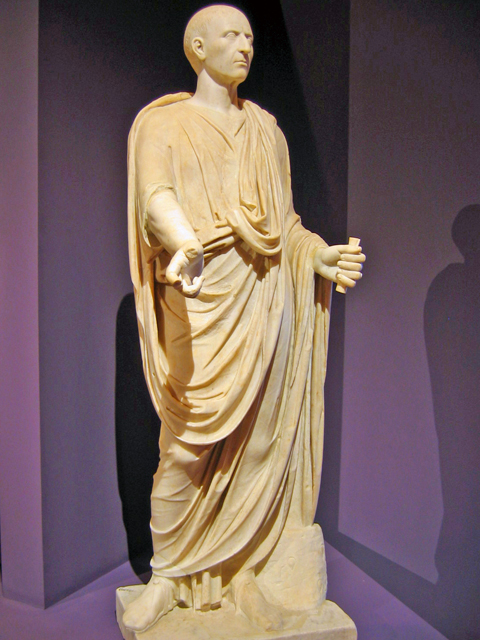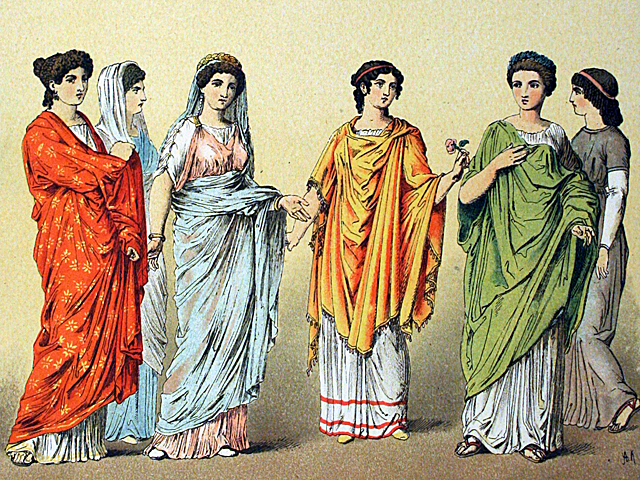All in all, Roman clothing was similar to the Greek.
The tunic was a piece of clothing for everyone. It was usually made up of two square woolen cloths which were connected at the shoulders and hung down to the knees. They were most commonly made out of uncolored wool and were therefore the color of oatmeal. - The tunic was held together at the waist with a belt. Those who were more well-to-do wore longer tunics.
The most famous piece of clothing for men was the toga, which was worn over the tunic. All freeborn were legally allowed to wear a toga. Usually, however, only men of the upper class – the “elected people” – wore a toga as a sign of an official mission: magistrates and senators wore them when they were carrying out their state obligations. But putting on such a toga was not an easy task - the material was folded and artfully draped over the shoulders! That is why they were often replaced with a cloak (pallium), but this was frowned upon in some circles.

The piece of clothing that was more popular than the toga in the end was the simple tunic, which was worn by men as well as women: a simple shirt, usually of white wool or linen made up of two parts sewn together. They were worn day and night. If you wanted to relax at home, you loosened the belt. In winter, people would wear up to four tunics layered on top of one another!
A special kind of tunic for women was the stole: it was favored in particular by matrons from the upper class and was characterized by a purple border on the lower hem. Of course women wore something like underclothes under the tunic: an apron and chest band. Women of the common classes were not allowed to wear stoles and probably didn‘t have the money for such elaborate clothing.
In the imperial period, the tunic was replaced by a cloak called pallium for men and palla for women. The cloak, which was taken from the Greeks, was easy to throw over the shoulders and usually went down to the ankles. The most popular color was purple.
If the weather was bad, there was also a poncho (paenula) with a hood, made of a rough woolen material. It was a funnel-shaped all-weather cloak without sleeves. Even simple folk could afford it!
In a society like that of the Romans, in which social position was put on display with status symbols and external signs, the discrepancy between rich and poor manifested itself in the clothing and in particular in the cloak. This was done with outward splendor, opposition, attracting attention, or a purposefully unkempt appearance – just like today!

The tunic was a piece of clothing for everyone. It was usually made up of two square woolen cloths which were connected at the shoulders and hung down to the knees. They were most commonly made out of uncolored wool and were therefore the color of oatmeal. - The tunic was held together at the waist with a belt. Those who were more well-to-do wore longer tunics.
The most famous piece of clothing for men was the toga, which was worn over the tunic. All freeborn were legally allowed to wear a toga. Usually, however, only men of the upper class – the “elected people” – wore a toga as a sign of an official mission: magistrates and senators wore them when they were carrying out their state obligations. But putting on such a toga was not an easy task - the material was folded and artfully draped over the shoulders! That is why they were often replaced with a cloak (pallium), but this was frowned upon in some circles.

The piece of clothing that was more popular than the toga in the end was the simple tunic, which was worn by men as well as women: a simple shirt, usually of white wool or linen made up of two parts sewn together. They were worn day and night. If you wanted to relax at home, you loosened the belt. In winter, people would wear up to four tunics layered on top of one another!
A special kind of tunic for women was the stole: it was favored in particular by matrons from the upper class and was characterized by a purple border on the lower hem. Of course women wore something like underclothes under the tunic: an apron and chest band. Women of the common classes were not allowed to wear stoles and probably didn‘t have the money for such elaborate clothing.
In the imperial period, the tunic was replaced by a cloak called pallium for men and palla for women. The cloak, which was taken from the Greeks, was easy to throw over the shoulders and usually went down to the ankles. The most popular color was purple.
If the weather was bad, there was also a poncho (paenula) with a hood, made of a rough woolen material. It was a funnel-shaped all-weather cloak without sleeves. Even simple folk could afford it!
In a society like that of the Romans, in which social position was put on display with status symbols and external signs, the discrepancy between rich and poor manifested itself in the clothing and in particular in the cloak. This was done with outward splendor, opposition, attracting attention, or a purposefully unkempt appearance – just like today!

No comments:
Post a Comment